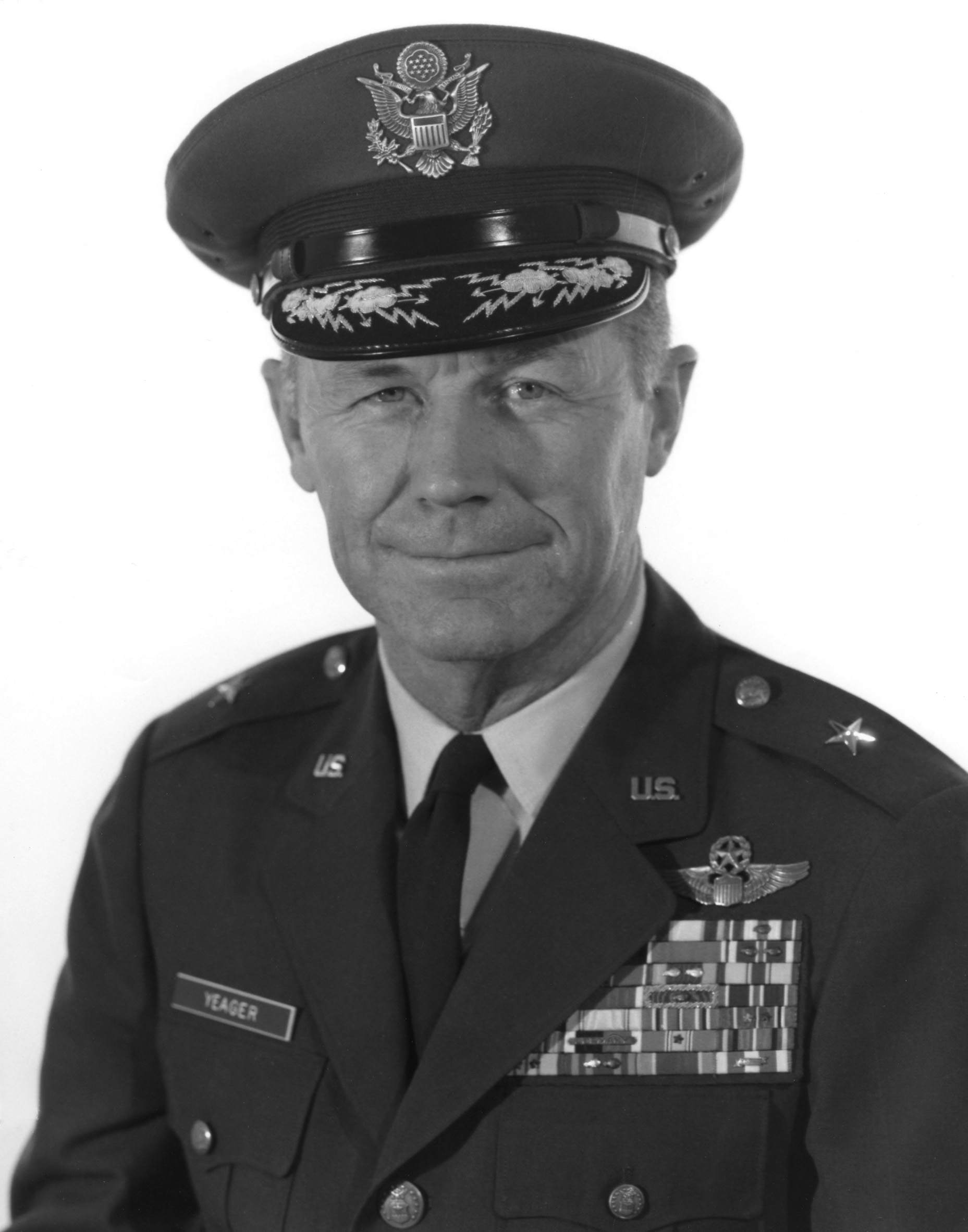
Brigadier General Charles Elwood Yeager, United States Air Force, was born at Myra, Lincoln County, West Virginia, 13 February 1923. He was the second of five children of Albert Halley Yeager, a gas field driller, and Susan Florence Sizemore Yeager. He attended Hamlin High School, at Hamlin, West Virginia, graduating in 1940.
Chuck Yeager enlisted as a private, Air Corps, United States Army, 12 September 1941, at Fort Thomas, Newport, Kentucky. He was 5 feet, 8 inches tall (1.73 meters) and weighed 133 pounds (60 kilograms), with brown hair and blue eyes. He was assigned service number 15067845. Initially an aircraft mechanic, he soon applied for flight training. Private Yeager was accepted into the “flying sergeant” program.
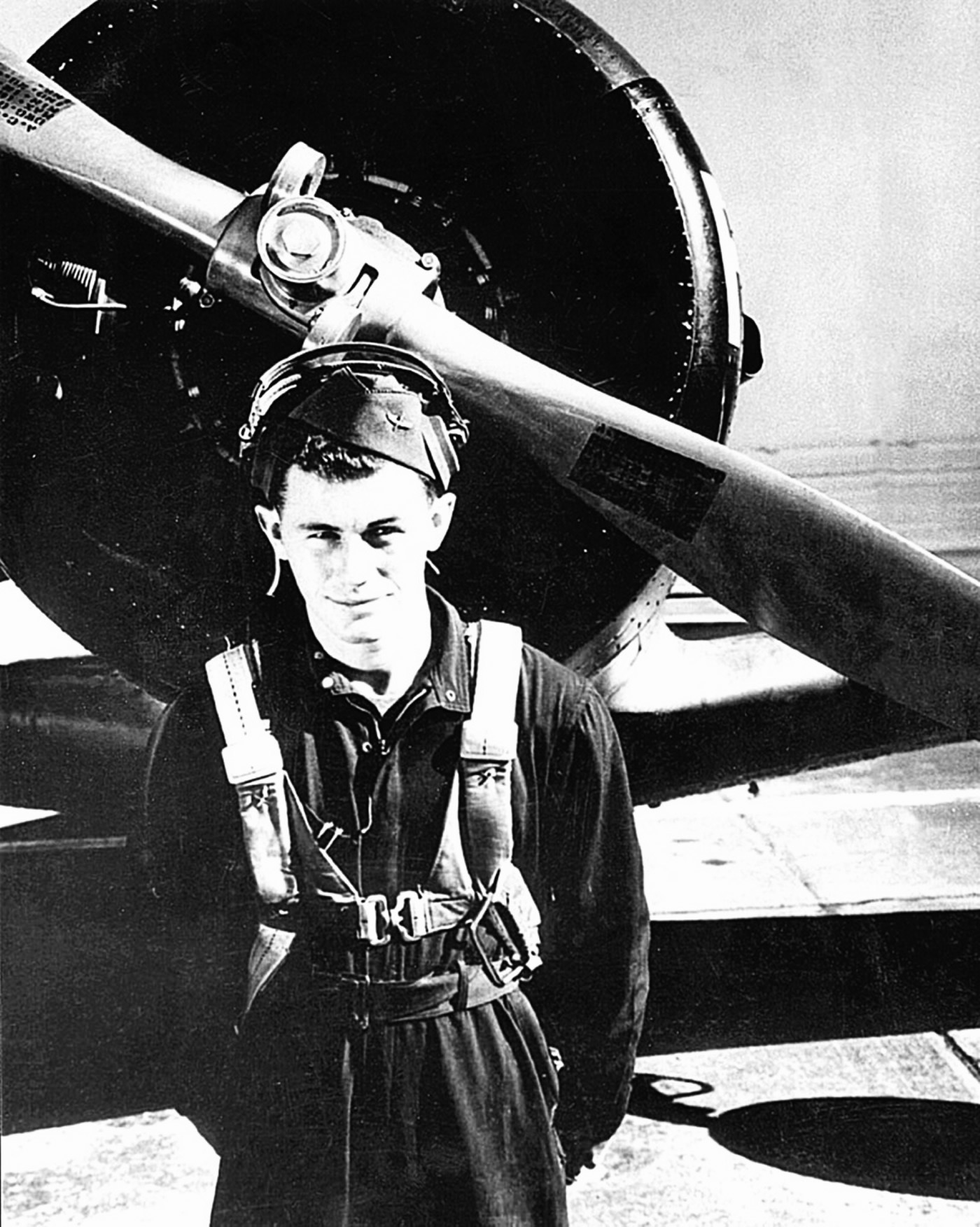
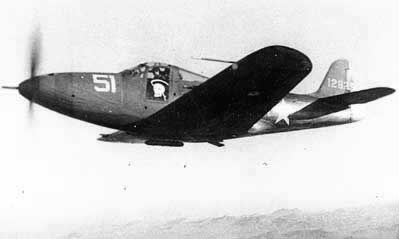
Sergeant Yeager completed flight training at Yuma, Arizona, and on 10 March 1943, he was given a warrant as a Flight Officer, Air Corps, Army of the United States.
Assigned to the 363rd Fighter Squadron at Tonopah, Nevada, Flight Officer Yeager completed advanced training as a fighter pilot in the Bell P-39 Airacobra.
On 23 October 1943, while practicing tactics against a formation of Consolidated B-24 Liberator bombers, the engine of Yeager’s P-39 exploded. He wrote,
I was indicating about 400 mph when there was a roaring explosion in the back. Fire came out from under my seat and the airplane flew apart in different directions. I jettisoned the door and stuck my head out, and the prop wash seemed to stretch my neck three feet. I jumped for it. When the chute opened, I was knocked unconscious. . . I was moaning and groaning in a damned hospital bed. My back was fractured and it hurt like hell.
—Yeager: An Autobiography, Charles E. Yeager and Leo Janos, Bantam Books, Inc., New York, 1985, Chapter 3 at Page 21
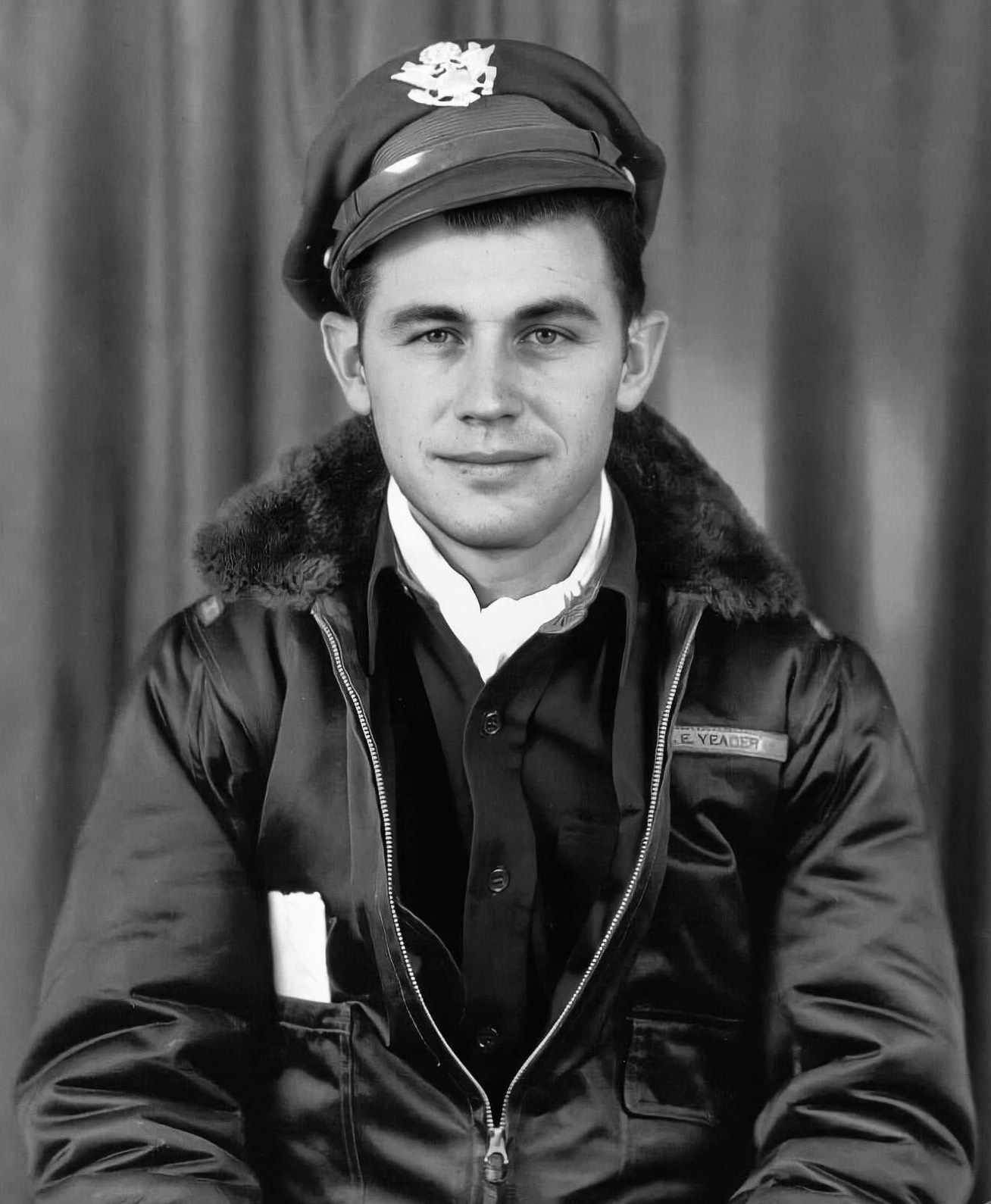
When the 363rd deployed to England in November 1943, he transitioned to the North American Aviation P-51B Mustang. He named his P-51B-5-NA, 43-6762, Glamourus Glen, after his girlfriend. The airplane carried the squadron identification markings B6 Y on its fuselage. On 4 March 1944, he shot down an enemy Messerschmitt Bf-109G.
On his eighth combat mission, the following day, Yeager was himself shot down east of Bourdeaux, France, by Focke-Wulf Fw 190A 4 flown by Unteroffizier Irmfried Klotz.
. . . The world exploded and I ducked to protect my face with my hands, and when I looked a second later, my engine was on fire, and there was a gaping hole in my wingtip. The airplane began to spin. It happened so fast, there was no time to panic. I knew I was going down; I was barely able to unfasten my safety belt and crawl over the seat before my burning P-51 began to snap and roll, heading for the ground. I just fell out of the cockpit when the plane turned upside down—my canopy was shot away.
—Yeager: an Autobiography, by Charles E. Yeager and Leo Janos, Bantam Books, New York, 1985, Chapter 4 at Page 26.
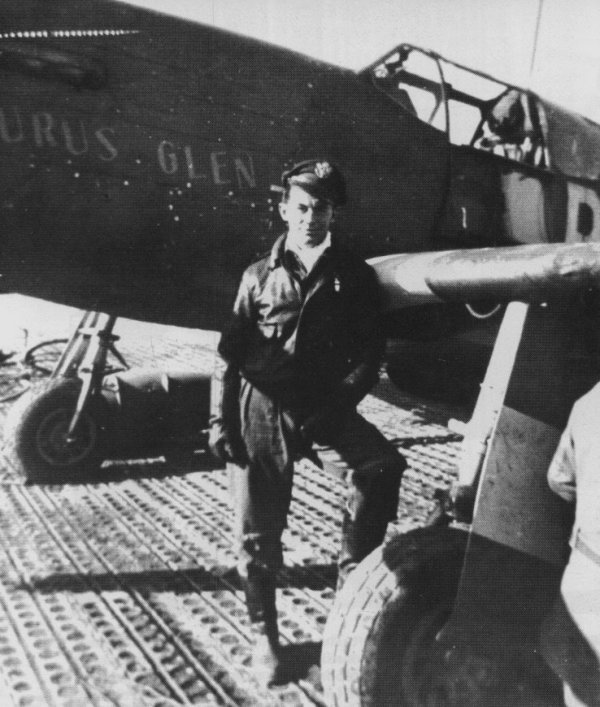
Yeager was slightly wounded. His Mustang was destroyed. Over the next few months he evaded enemy soldiers and escaped through France and Spain, returning to England in May 1944. He returned to combat with a new P-51D-5-NA Mustang, 44-13897, which he named Glamorous Glenn II.¹ He later flew Glamorous Glen III, P-51D-15-NA Mustang, 44-14888.²
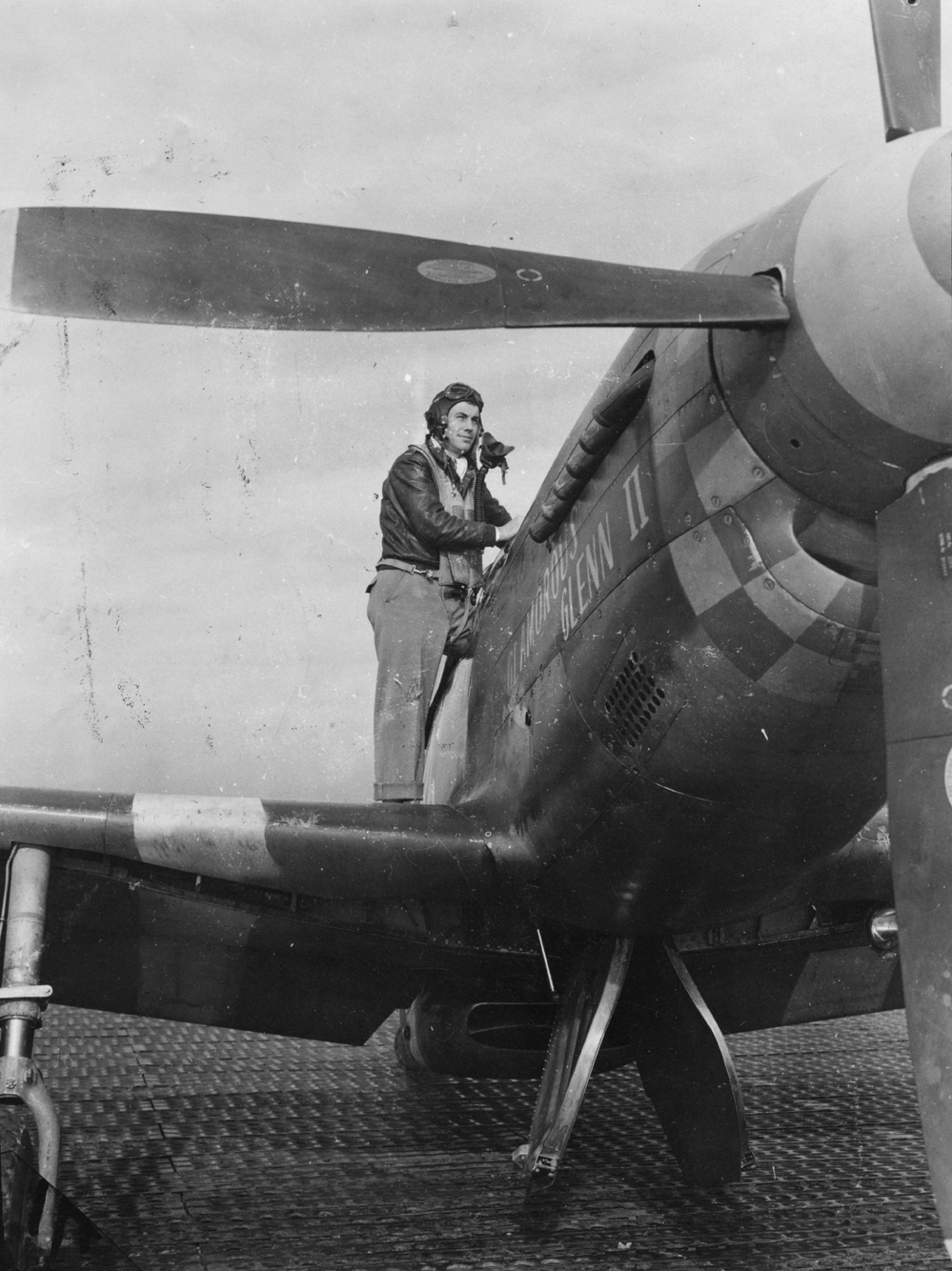
Flight Officer Yeager was commissioned as a 2nd lieutenant, Air Corps, Army of the United States, 6 July 1944. A few months later, 24 October 1944, he was promoted to the rank of captain, A.U.S. Between 4 March and 27 November 1944, Captain Yeager was officially credited with 11.5 enemy aircraft destroyed during 67 combat missions.
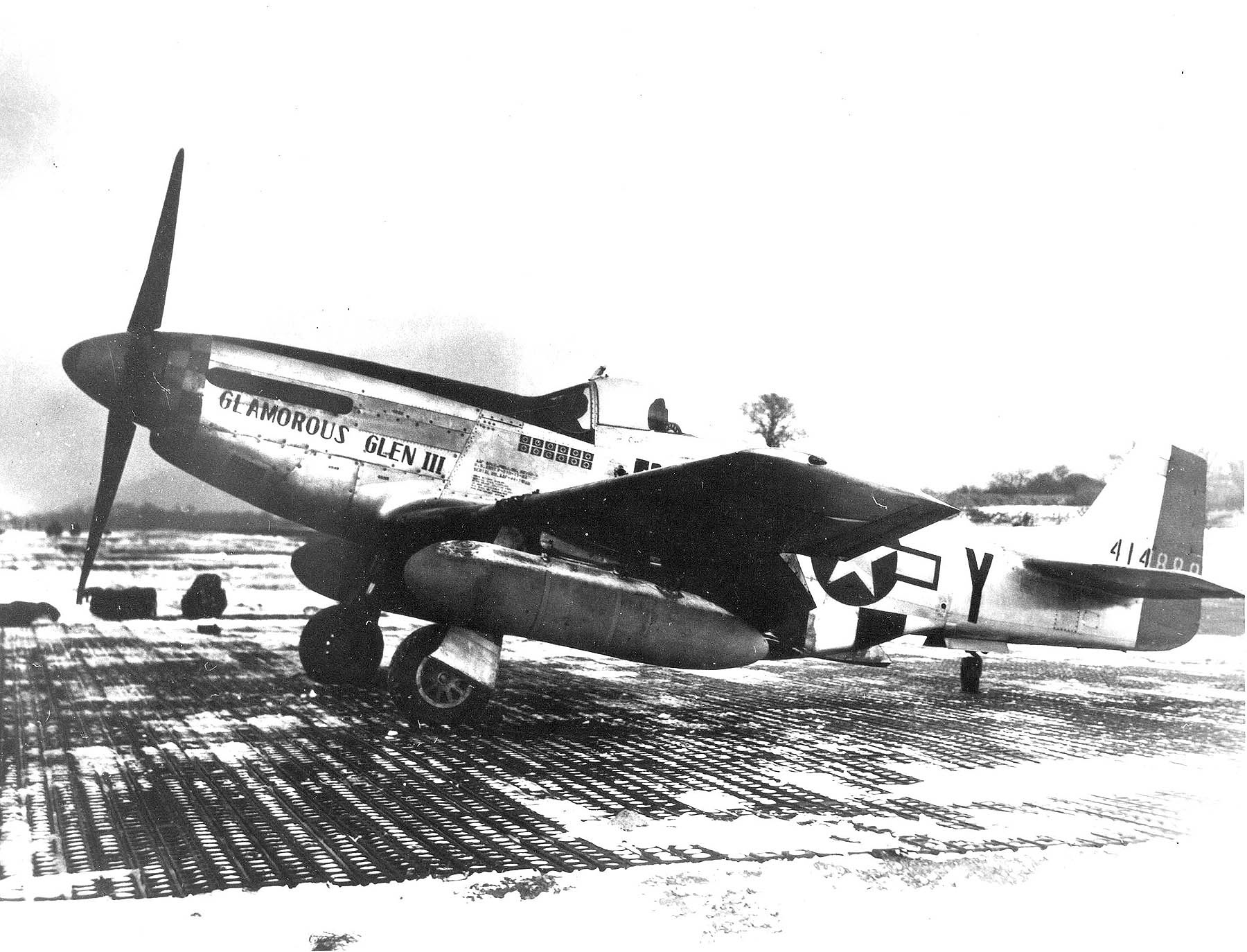
During World War II, Captain Yeager had been awarded the Silver Star with one oak leaf cluster (two awards); Distinguished Flying Cross; Bronze Star Medal with “V” (for valor); Air Medal with 6 oak leaf clusters (7 awards); and the Purple Heart.
With the end of the War in Europe approaching, Yeager was rotated back to the United States.
Captain Yeager married Miss Glennis Faye Dickhouse of Oroville, California, 26 February 1945, at at the Yeager family home in Hamlin, West Virginia. The double-ring ceremony was presided over by Rev. Mr. W. A. DeBar of the Trinity Methodist Church. “The pretty brunette was attired in a light aqua crepe dress of street length. Her accessories were black and her corsage was fashioned of yellow rosebuds.”
— Oroville Mercury-Register, Vol. 72, No. 56, Wednesday, 7 March 1945, Page 2, Column 3
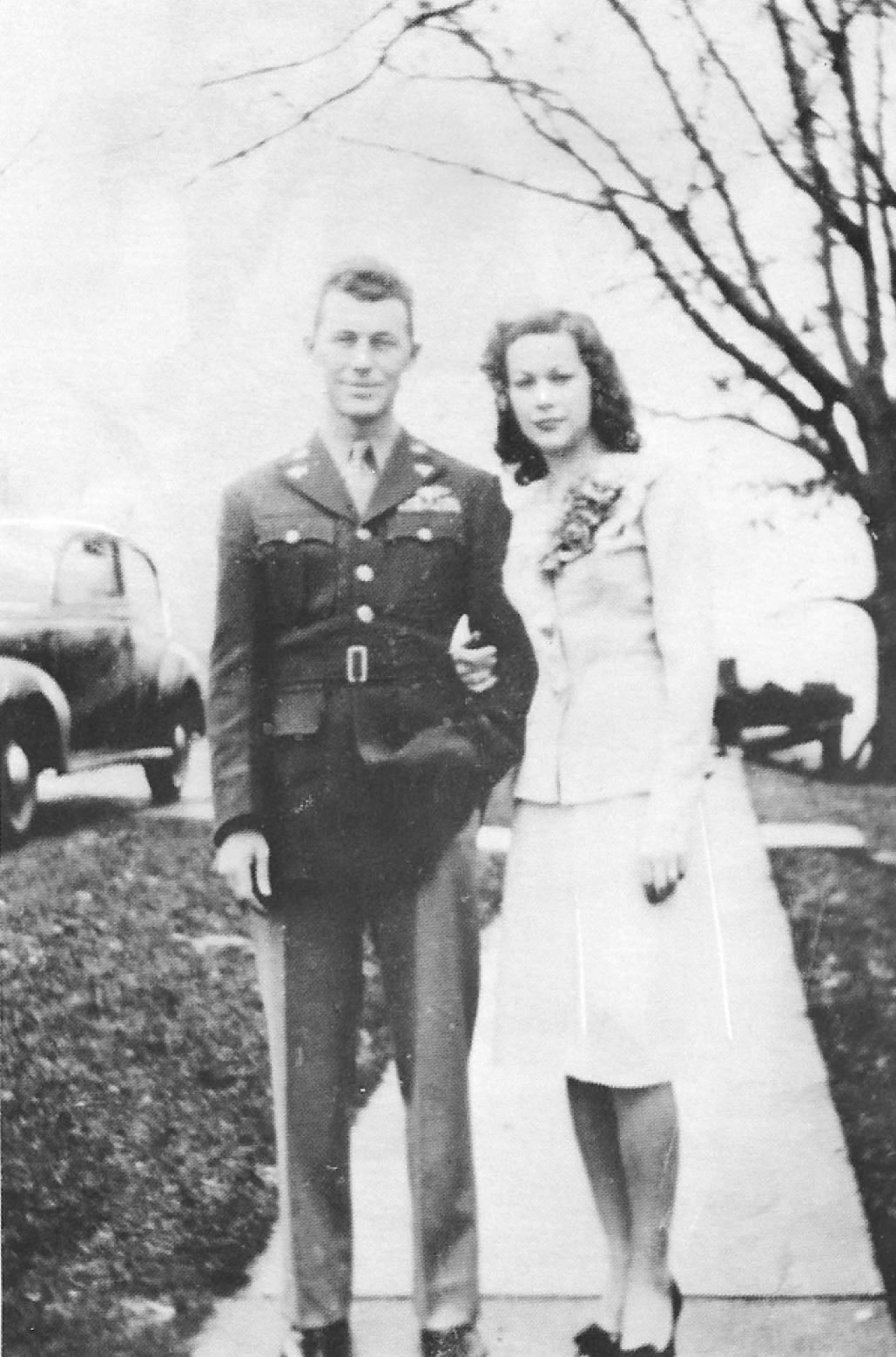
On 10 February 1947, Captain Yeager received a commission as a second lieutenant, Air Corps, United States Army, with date of rank retroactive to 6 July 1944 (the date of his A.U.S. commission). He was promoted to first lieutenant on 6 July 1947. (These were permanent Regular Army ranks. Yeager continued to serve in the temporary rank of captain.) When the United States Air Force was established as a separate military service, 18 September 1947, Yeager became an Air Force officer.
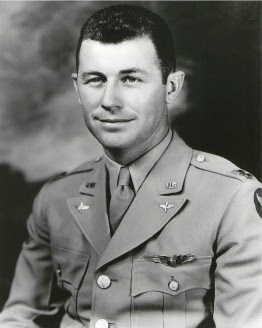
Captain Yeager was assigned to the six-month test pilot school at Wright Field, Dayton, Ohio. He took part in several test projects, including the Lockheed P-80 Shooting Star and Republic P-84 Thunderjet. He also evaluated the German and Japanese fighter aircraft brought back to the United States after the war. Captain Yeager was then selected by Colonel Albert Boyd to fly the experimental Bell XS-1 rocket plane at Muroc Field in the high desert of southern California.
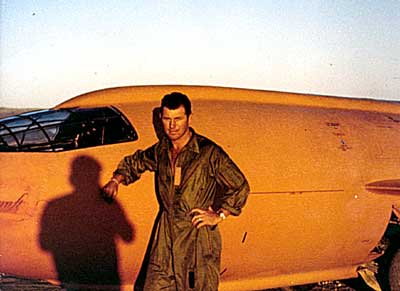
After a series of gliding and powered flights, on 14 October 1947, Captain Yeager and the XS-1 were dropped from a modified B-29 Superfortress at an altitude of 20,000 feet (6,048 meters). (Yeager had named his new rocket plane Glamorous Glennis.) Starting the 4-chambered Reaction Motors rocket engine, Yeager accelerated to Mach 1.06 at 42,000 feet. He had “broken” the Sound Barrier.
Yeager made more than 40 flights in the X-1 over the next two years, exceeding 1,000 miles per hour (1,610 kilometers per hour) and 70,000 feet (21,336 meters). He was awarded the Mackay and Collier Trophies in 1948. In 1949, the Fédération Aéronautique Internationale awarded its Gold Medal to Captain Yeager. General Yeager’s gold medal is in the collection of the Smithsonian Institution National Air and Space Museum, along with the Bell X-1 rocket plane, Glamorous Glennis.
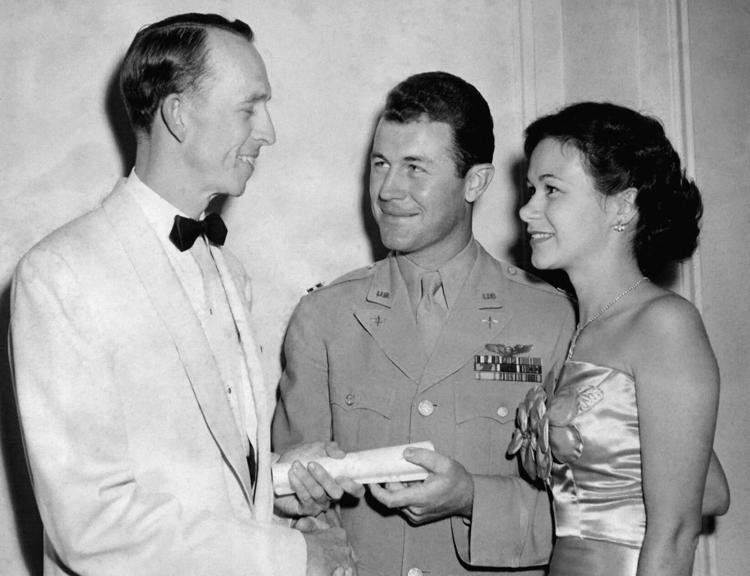
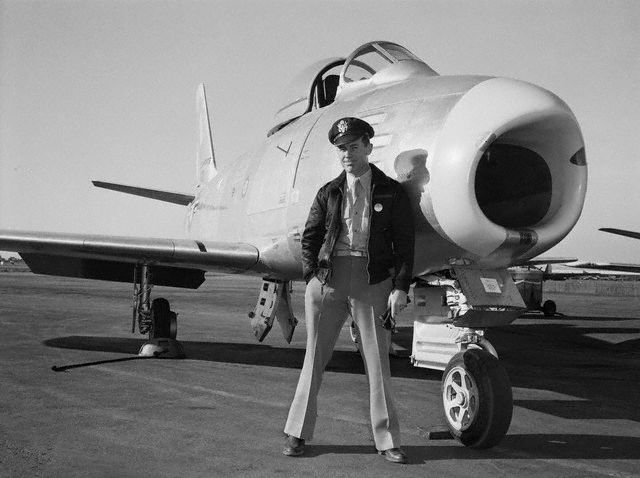
The X-1 was followed by the Bell X-1A. On 12 December 1953, Major Yeager flew the new rocket plane to 1,650 miles per hour (2,655 kilometers per hour), Mach 2.44, at 74,700 feet (22,769 meters).
After the rocket engine was shut down, the X-1A tumbled out of control—”divergent in three axes” in test pilot speak—and fell out of the sky. It dropped nearly 50,000 feet (15,240 meters) in 70 seconds. Yeager was exposed to accelerations of +8 to -1.5 g’s. The motion was so violent that Yeager cracked the rocket plane’s canopy with his flight helmet.
Yeager was finally able to recover by 30,000 feet (9,144 meters) and landed safely at Edwards Air Force Base.
Yeager later remarked that if the X-1A had an ejection seat he would have used it.
Bell Aircraft Corporation engineers had warned Yeager not to exceed Mach 2.3.
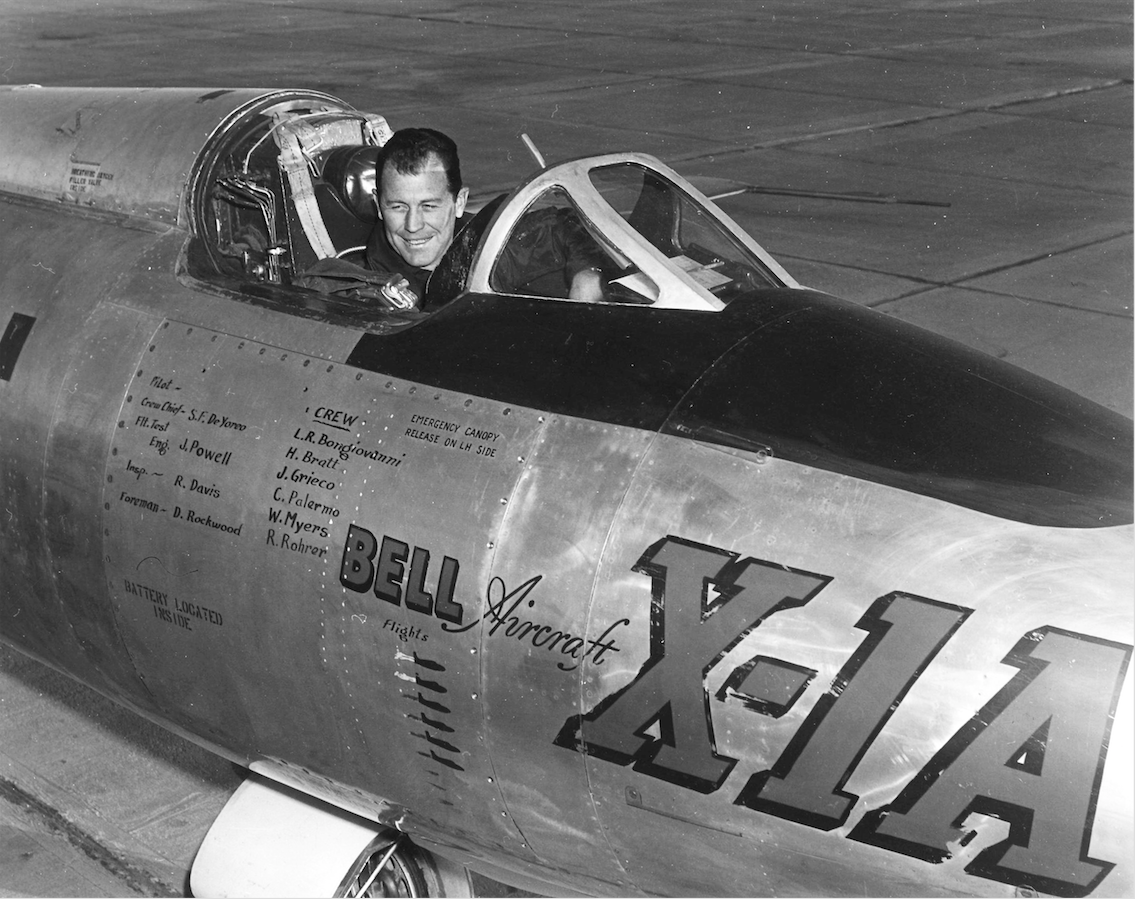
During the Korean War, Major Yeager test flew a captured North Korean Mikoyan-Gurevich MiG-15 fighter. Its pilot, Lieutenant No Kum-Sok, had flown it to Kimpo Air Base, Republic of South Korea, on 21 September 1953.
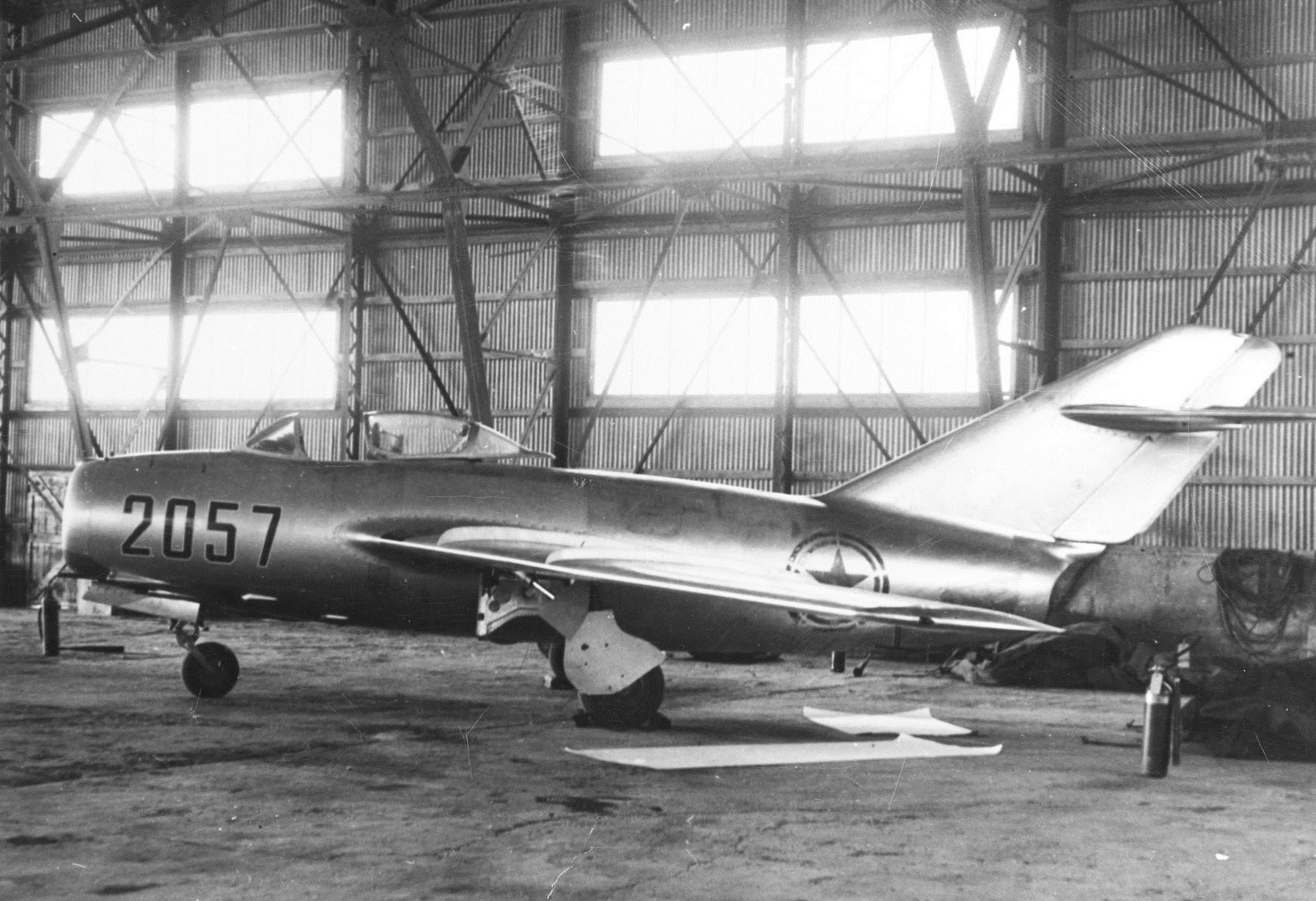
On 17 November 1954, in a ceremony at The White House, President Dwight D. Eisenhower presented the Harmon International Trophy to Major Yeager, for his Mach 2.44 flight. His friend, Jackie Cochran, was awarded the Harmon Aviatrix Trophy at the same time.
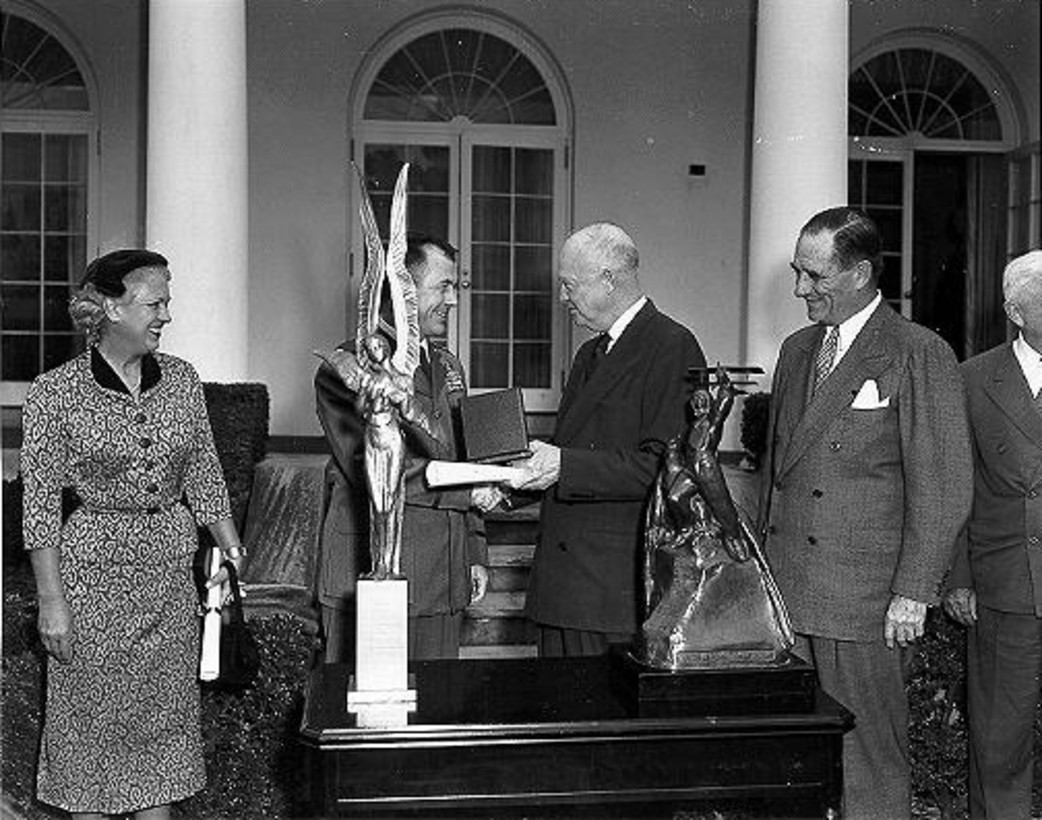
In 1954, Major Yeager was assigned to command the 417th Fighter Bomber Squadron at Hahn Air Base, Germany. The 417th flew the North American Aviation F-86H Sabre.
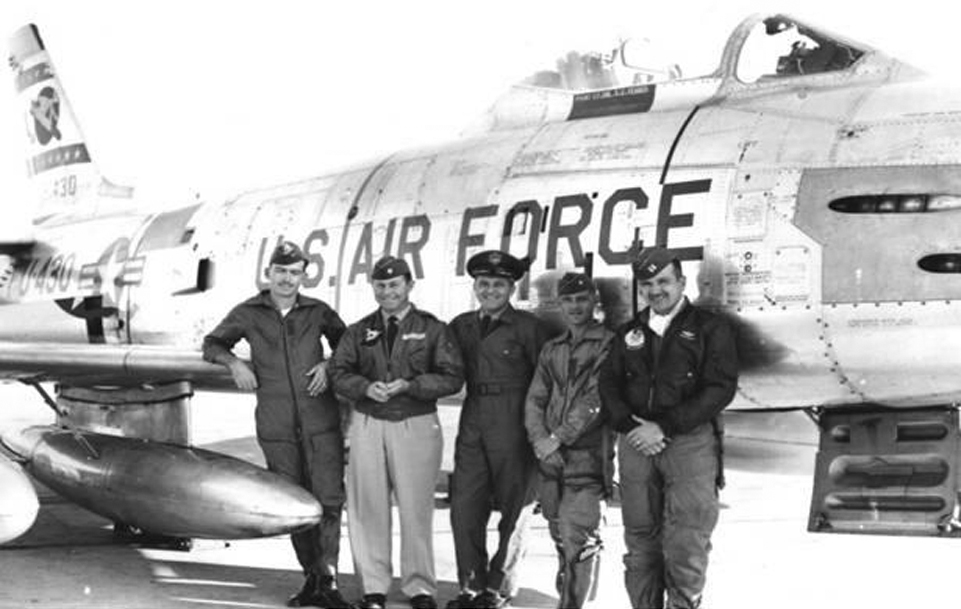
In 1958, Lieutenant Colonel Yeager assumed command of the 1st Fighter Day Squadron at George Air Force Base, Victorville, California, which was equipped with the North American Aviation F-100 Super Sabre.
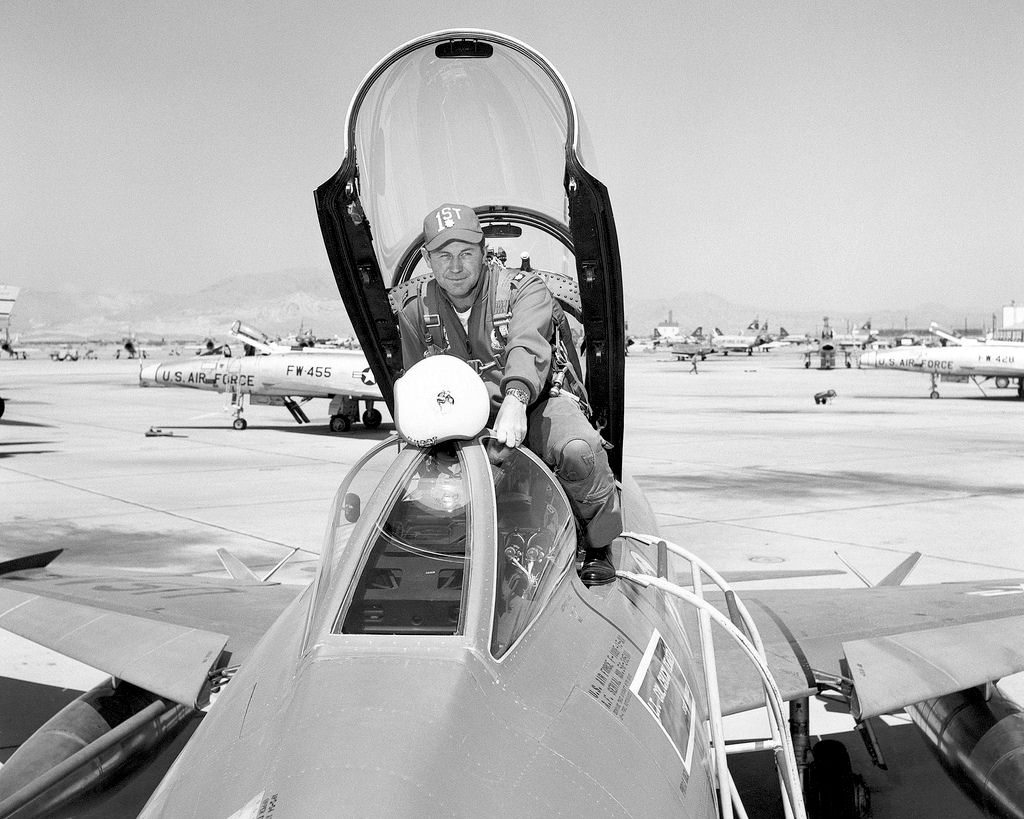
Yeager attended the Air War College at Maxwell AFB, Montgomery, Alabama, graduating in June 1961.
On 23 July 1962, Colonel Yeager returned to Edwards Air Force Base to become commandant of the Aerospace Research Pilot School.
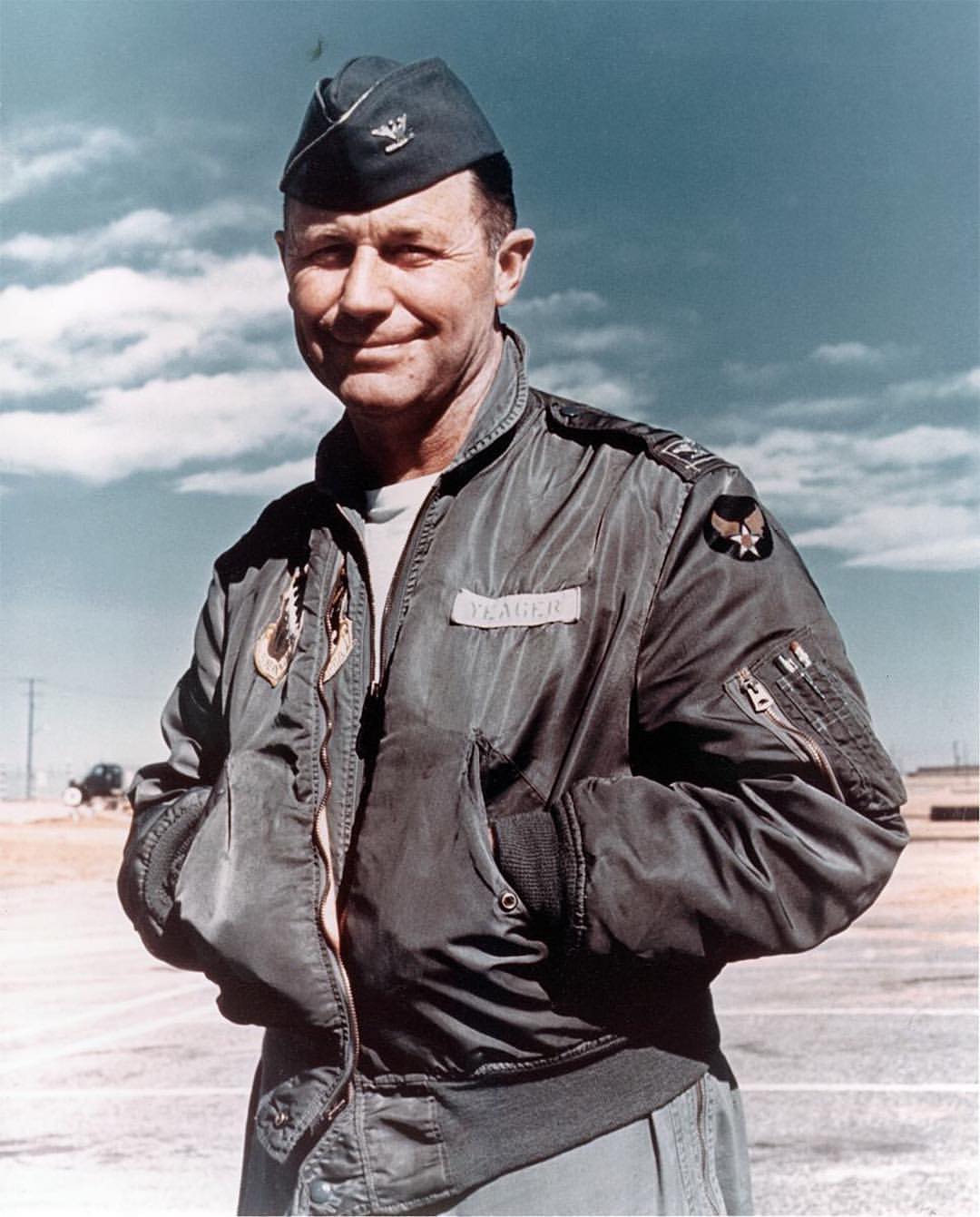
The Aerospace Research Pilots School trained all of the U.S. military’s astronaut candidates. One of the training aircraft was the Aerospace Trainer (AST), a highly-modifies Lockheed NF-104A Starfighter. The AST was equipped with a rocket engine and a reaction control system to provide pitch, roll and yaw control when at very high altitudes where the normal aircraft flight controls could not function.
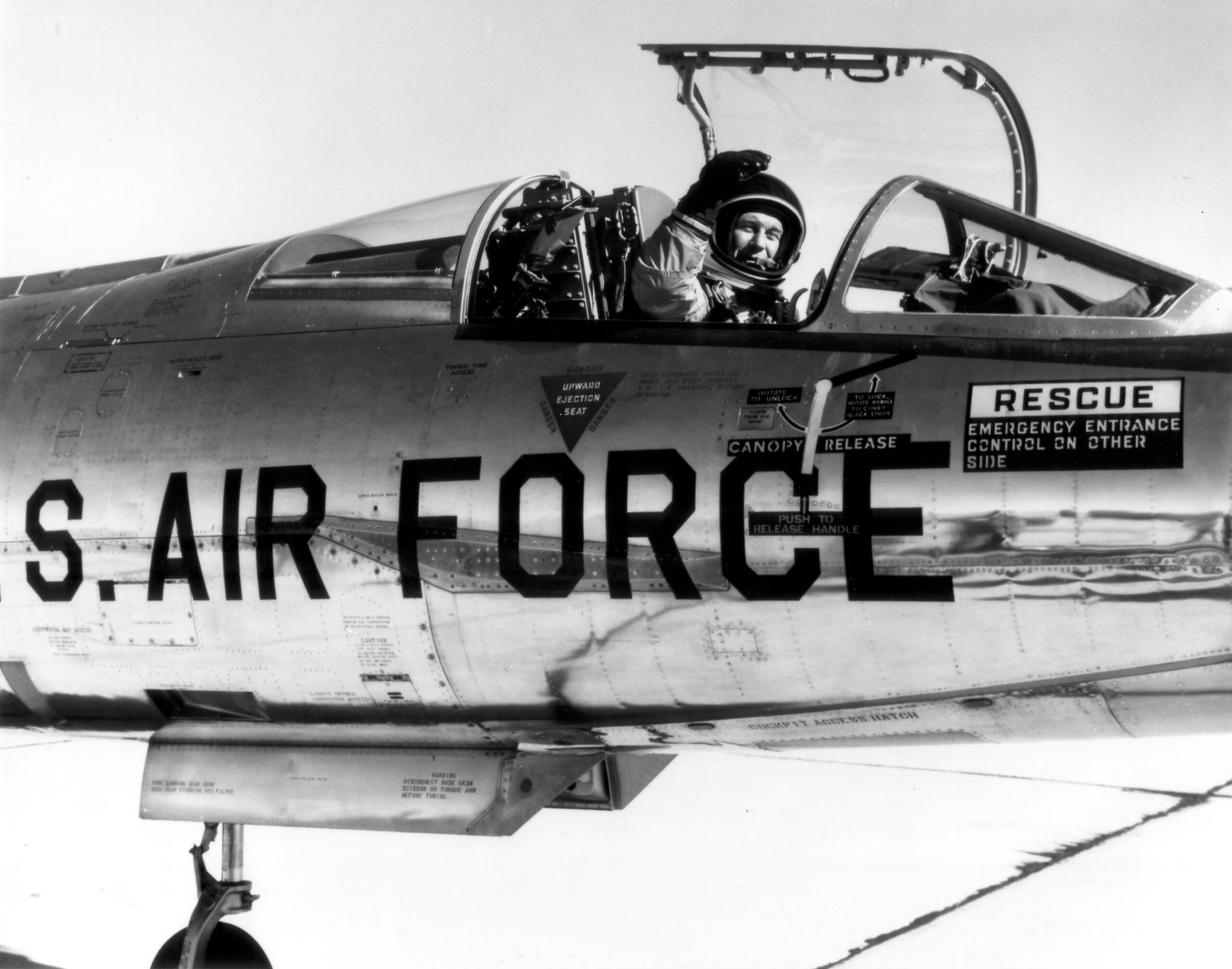
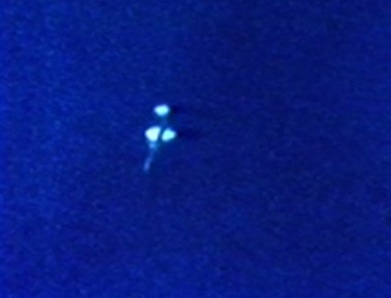
On 10 December 1963, Colonel Yeager was flying an AST, 56-762, on a zoom climb profile, aimingg for an altitude record at approximately 120,000 feet ( meters). He reached only 108,000 feet (32,918 meters) however. On reentry, the AST’s pitch angle was incorrect and its engine would not restart. The airplane went into a spin.
Yeager rode the out-of-control airplane down 80,000 feet (24,384 meters) before ejecting.
The data recorder would later indicate that the airplane made fourteen flat spins from 104,000 until impact on the desert floor. I stayed with it through thirteen of those spins before I punched out. I hated losing an expensive airplane, but I couldn’t think of anything else to do. . . I went ahead and punched out. . . .
— Yeager, An Autobiography, by Brigadier General Charles E. Yeager, U.S. Air Force (Retired) and Leo Janos, Bantam Books, New York, 1985, at Pages 279–281.
Colonel Yeager commanded the 405th Fighter Wing at Clark AFB, Philippine Islands, in July 1966. He flew 127 combat missions over Vietnam with the Martin B-57 Canberra light bomber.
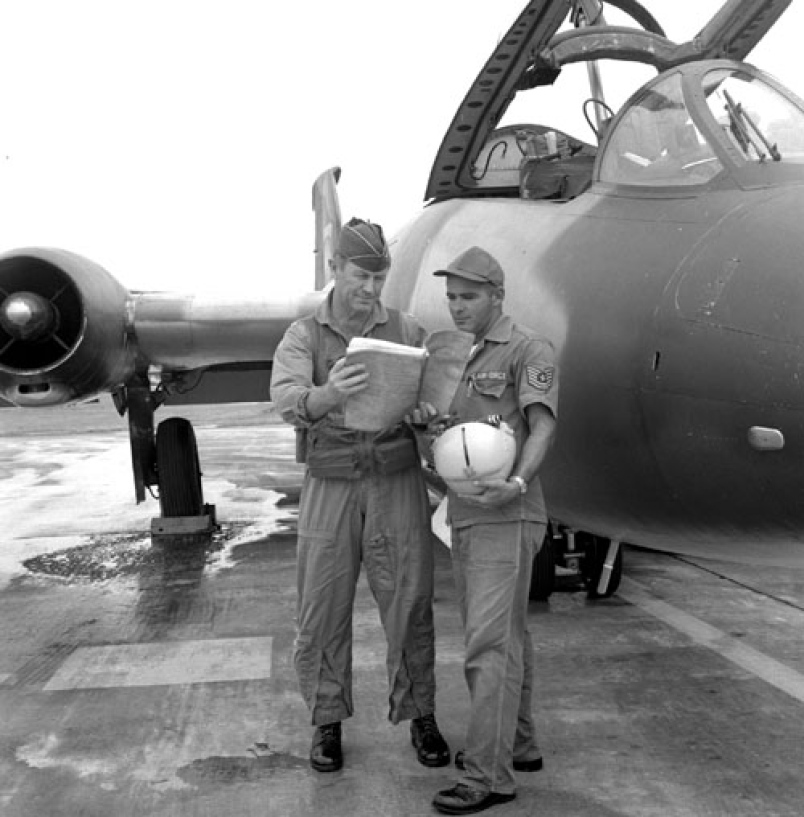
Returning to the United States in February 1968, Colonel Yeager took command of the 4th Tactical Fighter Wing, Seymour Johnson AFB, North Carolina. The 4th deployed to the Republic of Korea during the Pueblo Crisis.
Colonel Yeager was promoted to the rank of brigadier general, 1 August 1969 (date of rank 22 June 1969). He was appointed vice commander, Seventeenth Air Force, at Ramstein Air Base, Germany.

Brigadier General Yeager served as a U.S. defense representative to Pakistan from 1971 to 1973. He was then assigned to the Air Force Inspection and Safety Center, Norton AFB, near Riverside, California. He took command of the center June 1973.
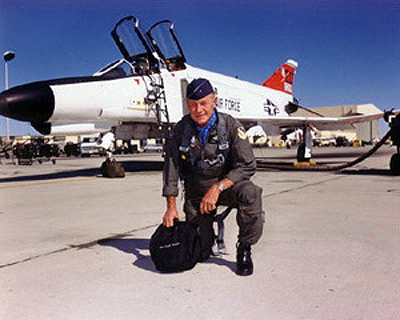
Brigadier General Yeager made his final flight as an active duty Air Force pilot in a McDonnell Douglas F-4E Phantom II at Edward Air Force Base, 28 February 1975. During his career, General Yeager flew 180 different aircraft types and accumulated 10,131.6 flight hours. He retired the following day, 1 March 1975, after 12,222 days of service.
Chuck Yeager’s popularity skyrocketed following the publication of Tom Wolfe’s book, The Right Stuff, in 1979, and the release of The Ladd Company’s movie which was based on it. (Yeager had a “cameo” appearance in the film.) He became a spokesperson for AC Delco and the Northrop Corporation’s F-20 Tigershark lightweight fighter prototype. In 1986 and 1988, he drove the pace car at the Indianapolis 500. Yeager co-wrote an autobiography, Yeager, with Leo Janos, published in 1985, and followed in 1988 with Press On!, co-authored by Charles Leerhsen.
In 1986, President Ronald Reagan appointed General Yeager to the Rogers Commission investigating the Challenger Disaster.
Glennis Yeager passed away 22 December 1990 at Travis Air Force Base, Sacramento, California.
TDiA was present at Edwards Air Force Base, 14 October 1997, on the 50th Anniversary of Yeager’s flight breaking the sound barrier. Flying in the forward cockpit of a McDonnell Douglas F-15D Eagle, with co-pilot Lieutenant Colonel Troy Fontaine and wingman Bob Hoover in a General Dynamics F-16 chase plane, Yeager again left a sonic boom in his path as he flew over the high desert.
On 22 August 2003, Chuck Yeager married Ms. Victoria Scott D’Angelo in a civil ceremony at Incline Village, Nevada.
Brigadier General Charles Elwood Yeager, United States Air Force (Retired) died at a hospital in Los Angeles, California, 7 December 2020, at the age of 97 years. His remains are buried at the Lincoln Memorial Cemetery, Myra, West Virginia.
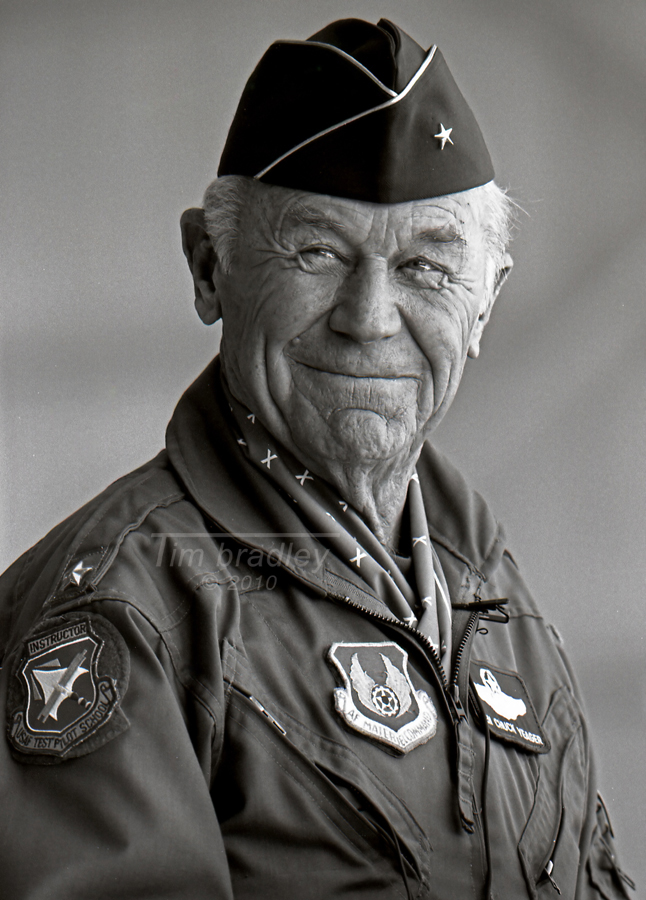
¹ Glamorous Glenn II had initially been assigned to Captain K. Peters, who had named it Daddy Rabbit. The fighter crashed in bad weather 18 October 1944. 2nd Lieutenant Horace M. Roycroft was killed.
² Glamorous Glen III, renamed Melody’s Answer, was lost in combat 2 March 1945, south of Wittenburg, Germany. Its pilot, Flight Officer Patrick L. Mallione, was killed in action. (MACR 12869)
© 2021, Bryan R. Swopes
Two weeks prior to the X-1 flight North American test pilot George Welch is thought to have exceeded the speed of sound in an F-86. Sonic booms were heard at Muroc dry lake that morning. Supposedly the claim was rejected because there was no telemetry set up at the field. Remains a controversy.
Thank you, Paul. In my opinion, George Welch absolutely did break the sound barrier before Yeager. Please see This Day in Aviation’s article for 1 October 1947 at https://www.thisdayinaviation.com/1-october-1947/ Interestingly, Yeager was not well known to the general public before the publication of Tom Wolfe’s “The Right Stuff” in 1979, when he became the public face of the research test pilot. Growing up in the ’50s and ’60s, I was well acquainted with Scott Crossfield, Pete Knight, Tony LeVier (a friend of my mother’s family), but I don’t think I had ever heard of Chuck Yeager.
Thanks Bryan. Best account I have seen of Welch’s flight. Many dispute the event but I believe it occurred. The 86 has always been my favorite fighter. A beautiful plane!
Yes it is!
Those of us in aviation knew Chuck and of Chuck long before “the right stuff” was written and yes several WWII pilots did exceed Mach in P-47s when in dives and full power but most never survived due to loss of control. However Chuck did it officially and with telemetry and observers which is the making of all records.
Thank you, Kurt. That’s why I specified “the general public.” As to how well known he was within the aviation community, I can’t say. That was before my time. Possibly the most highly complimentary thing ever said about Yeager by a contemporary test pilot was when Scott Crossfield wrote that he doubted that any pilot other than Yeager could have survived the inertial-coupling incident in the X-1A.
I was just doing some research and was checking the official Air Force list of U.S. fighter aces of World War II. With 11 credited kills, Chuck Yeager is ranked at number 144. Preceding him on the list are many very well-recognized names. For example, with 13 kills, Robin Olds ranked 118th. The man who very likely beat Chuck Yeager through the sound barrier, George S. Welch, is ranked 59th with 16 kills. . . See TDiA for 14 October 1947 for that story:
https://www.thisdayinaviation.com/14-october-1947/
As for P-47 pilots exceeding the speed of sound in dives, I doubt very much that that ever happened. See TDiA for 13 November 1942 for the story of Bunny Comstock and his high-speed dive in a P-47:
https://www.thisdayinaviation.com/13-november-1942/
Happy Birthday to a great Fighter Pilot !===
He may be a great pilot but only an arrogant ahole would put down another pilots accomplishments like Dick Rutan’s and Jeanna Yeager. Plus he was lucky after he got shot down in Germany not skilled.
As for balls, John Glenn and company. To me character is defined by skill and humility a very rare characteristic throughout history.
Although I have met General Yeager, I do not know him well enough to say whether or not he is “arrogant.” But I do disagree about “luck.” A fighter pilot may survive the war with some luck, but he doesn’t score that many aerial victories without a tremendous amount of skill. As for being shot down, you are aware that Major General Robert M. White, X-15 test pilot and Air Force Cross recipient, was also shot down and captured? Brigadier General Frank Kendal (“Pete”) Everest, Jr., X-2 test pilot was shot down and captured in the CBI in 1944. Gabby Gabreski was a PoW until the end of the war. Famed test pilot Bob Hoover was shot down, captured and remained a guest of the Luftwaffe until he stole an Fw 190 and flew away? General Yeager volunteered to serve his country before we were at war. He rose from an enlisted man/aircraft mechanic to be one of the leading fighter aces of the war. He came from a small West Virginia town with a high school education and rose to the rank of Brigadier General, commanded various tactical Air Force units, as well as the Air Force Flight Test Center at Edwards Air Force Base. He served in combat in two wars. Arrogant? Maybe. But I think we can cut the General a little slack.
Happy birthday Chuck Yeager.chuck said Bob Hover was the greatest pilot who ever lived.
I wouldn’t argue with that.
I would rank Joe Engle right there with Yeager and Hoover. He was the best I ever saw, especially flying the F-100. He later flew the X-15 and the Space Shuttle.
Joe Engle HAND FLEW the Columbia during its Mach 25 reentry. He is definitely a Contender for Best.
Fortunate to have a drink or two one night in Wichita with Joe Engle. Great guy.
Roommates at Aviano AB, Italy 1960 in the 309th Tac. Ftr. Sq. Flying F-100s. We relieved Yeager’s Squadron the 306th on that deployment. Joe then attended the Test Pilot School at Edwards. Remained there to fly the X-15 16 times. Then Apollo where he was trained as a Lunar Module Pilot. Program ended before he got a launch. Space Shuttle next where he did initial testing on the space craft then flew in orbit twice. The best pilot I have known.
I was one of the flight surgeons at Edwards from 1984-1988, and had the opportunity to meet BGen Yeager multiple times. He was always polite and friendly. Did he have an ego? Yeah, but so does just about every fighter pilot I ever met, goes with the territory. Arrogant? No, don’t think so, at least I never saw it. Of course, most pilots,(even retired Generals) are on their best behavior around the flight doc…
I’ve never met MGen Engle, but everybody I knew who had flown with him said he was one of the best pilots they ever saw.
Thank you, Dr Allen. Sounds right to me.
Since we are dropping names, I want to list the highest scoring P-51 ace, 98 year old Col. “Bud” Anderson. Best friend, Yeager called him “the greatest fighter pilot I’ve ever seen.”
Great comments about some Great pilots. Yeager is One of those Greats.
I was a student at the 15th AF NCOA, March AFB,CA in Jan 1966. A guest speaker was Col. Yeager. He sat on the desk for an hour plus session. A humble ,but cocky, Fighter Pilot. RIP Sir!
The picture of BGen Yeager in front of the B-57 Canberra brought back memories. I was a newly minted 2/Lt. ROTC electrical engineer assigned to WCEGT-3 Tactical Bombing at WPAFB in 1951. The Canberra was assigned the “night intruder” mission in Korea at low altitude in mountainous terrain. This required more of a gunsight than a bombsight. We had the AN/APG-31 which became useless in rain or carbon dioxide. Naval ordinance plant in Indianapolis was designing the AN/APG-46 which overcame these limitations. I called NOPI and arranged a meeting with their Project Engineer, took a VOCO and drove there to meet with him. He arranged to have extra radars built for flight tests at Elgin. I had no authorization to do so.
Typographical error in Bell X-1 paragraph . “After a series of gliding and powered flights, on 14 October 1947” not 1957 I think.
Thank you. I’ll fix it.
another error. Article says he was shot down in March 1945 over France, then E&Ed his way to Spain and back to England in 1944.
Thanks for catching the mistake, Dennis. I have corrected it.
It’s OK to be a little cocky. It is even fun at times. 🙂 Just don’t over do it.
You don’t strap yourself into a piece of hurtling machinery without a certain amount of ego.
Had a memorable trip with Gen Yeager (then Col) to DC in a T Bird so he could attend the Collier Trophy Presentation at the request of Gen LeMay. Did things his way.
Dear Sir/Madame,
I was Cambodian Army veterant officer. I joined Marshal Lon Nol from 18th March 1970 to October 1993. I was admired and respect Brigadier General Charles E. Yeager US Air Force (Retired) since he was born and died.
Bryan
Is the year correct in this line from the Chuck Yeager story?
“The airplane carried the squadron identification markings B6 Y on its fuselage. On 4 March 1945, he shot down an enemy Messerschmitt Bf-109G.”
because the next date is before that is in 44
Thanks for catching my mistake, Steve. I have corrected it.